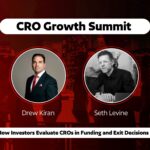
Precision in the First 90 Days: A Revenue Leader’s Operating System for the Modern Funnel

The first 90 days in a senior sales leadership role are often described as a “learning period.” In reality, they function much more like a public stress test. Boards, CEOs, and frontline teams are all watching to see whether the new leader can bring clarity to a complex system, establish credible priorities, and demonstrate visible progress against revenue goals. In this environment, improvisation is risky and generic 30-60-90 templates are not enough. What’s needed is a structured way to diagnose the revenue engine—and an equally structured way to translate that diagnosis into action.
Over the past several years, working with CROs and sales leaders across industries, a repeatable pattern has emerged. The leaders who successfully navigate this early window do two things unusually well. First, they approach the revenue organization as a system, not a collection of isolated functions. Second, they move from insight to execution quickly, using a clear, written plan as the backbone of their first 90 days. The article that follows outlines that system-level view of the funnel and argues that pairing it with a guided, interactive tool—such as the 30-60-90 planning agent—is no longer a luxury, but a necessity for modern sales leadership.
Diagnosing the Top of Funnel: Understanding How Revenue Begins
Any attempt to improve a revenue engine has to begin where revenue actually starts: the top of the funnel. For a new sales leader, the first 15 days should be dominated by a careful, data-informed assessment of lead generation and outbound motion. This means scrutinizing how meetings are booked, how inbound leads are handled, how outbound campaigns are structured, and how efficiently SDR and BDR teams convert activity into qualified opportunities.
In many organizations, apparent activity can mask real underperformance. Connection rates on outbound calls may be low, email engagement may be poor, and CRM records may be incomplete or inconsistent. Without an explicit framework, it is easy for leaders to rely on anecdote: a few strong performers, a handful of major accounts, and a general sense that “we’re busy.” A systematic review forces a different question: is the top of the funnel designed and operated in a way that can scale?
This is where a planning tool such as the 30-60-90 planning agent begins to demonstrate its value. Rather than leaving the leader to mentally juggle dozens of observations, the agent prompts structured reflection: What are your current conversion rates? How consistently are outbound plays executed? Where is data missing? By walking through these questions and capturing them in a unified plan, the leader moves from scattered insight to a clear set of top-of-funnel priorities that can be communicated and acted upon.
Examining the Middle of the Funnel: Where Opportunities Quietly Erode
Once the leader has sufficient visibility into how opportunities are created, attention must shift to how they progress. The middle of the funnel—typically the space between initial discovery or demo and proof of value—is often where pipeline appears healthy on paper but underdelivers in practice. Deals linger in intermediate stages, next steps are vague, and “ghosting” becomes a familiar pattern.
An effective mid-funnel review requires more than scanning a pipeline report. It involves examining the quality of discovery, the clarity of proposed value, and the discipline of follow-up. Are proof-of-value efforts structured and time-bound, or open-ended and reactive? Do account executives have a consistent approach to advancing opportunities, or does each one operate according to personal preference? Are managers coaching to specific deal dynamics, or merely asking for updated close dates?
Leaders using the 30-60-90 planning agent are encouraged to document these observations in a repeatable structure. The agent helps them identify drop-off points, quantify where opportunities are stalling, and specify the interventions required—such as redefining exit criteria for stages, tightening PoV design, or changing manager coaching rhythms. The result is not just an understanding that the middle of the funnel is a problem, but a concrete plan to change how it functions.
Assessing Closing Discipline: Turning Pipeline into Revenue
The third major focus area in the first 90 days is closing execution. This is where the revenue organization’s discipline—or lack of it—becomes fully visible. Forecast accuracy, late-stage slippage, and inconsistent closing behavior are rarely isolated issues; they are the outcome of how the entire system is managed.
A rigorous assessment of closing discipline goes beyond counting wins and losses. It requires looking closely at forecast methodology, deal qualification standards, and the routines by which leaders and managers review opportunities. Are there clear criteria for what constitutes a late-stage deal? Is there a shared language around risk? Do managers routinely engage in strategic deal reviews, or do they simply aggregate rep-level optimism into an inflated forecast?
Here again, the 30-60-90 planning agent provides more than a checklist. It acts as a structured companion, guiding the leader to document gaps in closing behavior, identify misalignments between forecast and reality, and commit to specific changes—be it redefining forecast categories, formalizing weekly deal review cadences, or investing in targeted training. The agent helps transform concern about closing performance into a sequenced set of actions that can be tracked over time.
Integrating Post-Sale Engagement: Aligning Sales with Net Revenue Retention
Although many sales leaders focus their first 90 days primarily on pre-sale activities, the true health of a modern revenue organization is reflected as much in retention and expansion as in new business. Net Revenue Retention (NRR) has become a central metric for recurring revenue businesses, and yet sales leadership is often only loosely connected to what happens after the contract is signed.
A thoughtful leader will dedicate a portion of the first 90 days to understanding implementation, onboarding, and customer success. How quickly do customers reach first value? What proportion of accounts show meaningful product usage within the first 30, 60, or 90 days? How are risk signals captured and escalated? Are there clear plays for expansion, and do they align with what was promised during the sales cycle?
The 30-60-90 planning agent encourages leaders to treat these questions as core to their 30-60-90 plan, rather than as a later-phase concern. By embedding post-sale engagement into the same planning framework as top-, mid-, and bottom-of-funnel initiatives, the leader can design a more integrated revenue system. This might include joint operating rhythms with customer success, aligned KPIs, and feedback loops that bring usage and renewal insights back into sales strategy and messaging.
Translating Diagnosis into Narrative and Action
The final task in the first 90 days is to synthesize these diagnostic efforts into a coherent narrative and roadmap. Boards and executive peers rarely need more data; they need a clear explanation of what is happening, why it is happening, and how the leader intends to address it over the next several quarters. That requires not only insight, but also structure.
An effective 90-day recap will tie together top-of-funnel health, mid-funnel conversion, closing discipline, and post-sale engagement. It will highlight a small number of critical constraints—such as poor outbound efficiency, inconsistent deal qualification, or slow time-to-value—and articulate the sequence in which these will be tackled. It will also define the operating cadence the leader intends to establish: the regular reviews, metrics, and cross-functional alignment needed to sustain improvement.
This is where the 30-60-90 planning agent serves as more than just a planning convenience; it becomes a tool for narrative coherence. Because the agent captures priorities, observations, and planned actions across all stages of the funnel, it provides a ready-made scaffold for executive communication. Leaders can draw directly from their agent-generated plan to present a structured, evidence-based view of the revenue system and the steps being taken to improve it.
From Planning as Ritual to Planning as Operating System
Many organizations treat 30-60-90 plans as a formality—a document created at the outset of a role and then filed away. The approach described here suggests a different perspective: planning is not a one-time exercise, but the core of a leader’s operating system. What distinguishes high-performing sales leaders is not that they have a plan, but that their plan is specific, adaptive, and deeply connected to how the revenue system actually works.
Using a guided tool like the 30-60-90 planning agent turns planning from a blank-page burden into an interactive process. It reduces cognitive load, prompts more honest assessment, and encourages leaders to commit to concrete, observable changes in behavior and process. It also creates an artifact that can be shared, revisited, and refined as the organization evolves beyond the first 90 days.
In an environment where revenue volatility is high and leadership tenure is often shorter than anticipated, the ability to establish clarity quickly is a strategic advantage. The first 90 days will always be a test. But with a structured framework and a planning companion like the 30-60-90 planning agent, they can also become the foundation for durable, system-level improvement rather than a scramble for quick wins.
Playbook
Executive Summary
The first 90 days in a sales leadership role aren’t just about listening and learning—they’re about building systems. In this article, we outline a strategic 90-day framework used by top CROs and revenue leaders—and introduce a guided planning agent, 306090.netnew.solutions, to help turn diagnostic insights into focused execution from day one.
Why the First 90 Days Are a Defining Moment
Stepping into a sales leadership role today—whether CRO, Head of Sales, or VP Revenue—is less about ramping up and more about immediately creating organizational confidence. You’re expected to triage, diagnose, and deliver traction fast.
Yet the challenge isn’t always a lack of vision—it’s a lack of operational structure to go from insight to action.
This is where leaders benefit most from guided, focused planning. At Net New Solutions, we’ve worked with hundreds of sales leaders and distilled what works into a repeatable framework—and now, a next-generation tool to operationalize it:
👉 306090.netnew.solutions
This free agent is built to support the exact strategy we outline below.
Phase 1: Top-of-Funnel Diagnosis (Days 1–15)
Your revenue engine starts with top-of-funnel motion: lead generation, outbound outreach, and meeting conversion. This is where pipeline health begins—and often, where noise is loudest.
Use your first two weeks to assess:
- Connection and engagement rates
- SDR/BDR workflows
- The true productivity of your outbound team
📉 If your outbound connection rate is under 20%, or your CRM is too messy to measure it, this is where your first fire drill starts.
👉 The 306090.netnew.solutions agent guides you through this evaluation step-by-step—so you can turn observation into a plan that’s actionable within days, not weeks.
Phase 2: Mid-Funnel Momentum (Days 16–30)
Mid-funnel is where deals begin to die quietly. Many leaders overlook this stage because activity exists—but progress stalls.
Assess:
- How many demos move to PoV (proof of value)?
- Where are prospects ghosting your team?
- Are reps clear on next steps and urgency?
Mid-funnel conversion friction is one of the biggest revenue leaks in B2B sales—and it’s usually not a talent issue, but a clarity issue.
👉 In 306090.netnew.solutions, you’ll identify where these drop-offs are happening and build a tailored action plan to improve mid-funnel movement using real deal data and behavioral trends.
Phase 3: Closing Precision (Days 31–45)
This is where pipelines get real—or exposed.
Most leadership teams believe they have a forecast problem. In reality, they have a clarity problem: unclear closing criteria, inconsistent deal reviews, and reps who confuse activity with progress.
Your role here:
- Pressure test forecast accuracy
- Evaluate manager-to-rep deal coaching
- Standardize late-stage deal management
👉 The agent at 306090.netnew.solutions will prompt you to assess closing rigor, diagnose rep behavior, and set a plan to improve forecast trust and late-stage performance.
Phase 4: Post-Sale Engagement & NRR (Days 46–75)
Revenue doesn’t end at close—it compounds after it.
By this point, you should be assessing:
- Deployment velocity
- Product usage patterns
- Customer engagement health
- Expansion/renewal visibility
💡 Your NRR (Net Revenue Retention) score is often the most important signal of go-to-market alignment, yet most CROs can’t influence it directly without visibility into this phase.
👉 The 30-60-90 Agent at 306090.netnew.solutions helps you build a system that includes Customer Success and informs outbound strategy, aligning Sales and CS around real usage data and account signals.
Phase 5: Strategic Reporting & Rhythm (Days 76–90)
You’ve diagnosed the system. Now it’s time to report up—and build forward.
Key actions:
- Present full-funnel insights to the board or executive team
- Define revenue team rhythms: pipeline reviews, forecast cadences, CS handoffs
- Outline your 6–12 month optimization roadmap
Most new revenue leaders fumble here—not because they lack insights, but because they fail to communicate a cohesive plan that integrates all funnel stages.
👉 306090.netnew.solutions not only guides you to build this plan—it helps you structure your communication so that strategy, execution, and reporting align around outcomes.
What Makes This Agent Different
Unlike traditional onboarding docs or generic planning templates, the 30-60-90 Planning Agent at 306090.netnew.solutions is:
- Structured, not static – It walks you through a modern sales organization’s real funnel dynamics.
- Built by operators – Based on hundreds of GTM transformations across SaaS, services, and product-led teams.
- Execution-ready – Generates a plan you can present to your CEO or use in team huddles—instantly.
Most importantly, it keeps leaders from spinning in circles during their most critical window of influence.
Your First 90 Days Aren’t a Warm-Up. They’re Your Foundation.
Your job is not to survive the first 90 days. It’s to establish a system that scales. A culture that executes. A funnel that compounds.
The difference between revenue leaders who lead and those who manage? The ability to turn insight into action—fast.
👉 That’s why your next step isn’t another deck or meeting. It’s 306090.netnew.solutions—a tool designed to help serious leaders execute from day one.
About the Author
Tim Savage is the founder of Net New Solutions, a revenue consulting firm that helps B2B leaders turn funnel chaos into clarity and scale. He works with GTM executives to architect outbound, optimize pipeline health, and drive NRR growth through full-funnel precision.
Reach him at tim@netnew.solutions
































